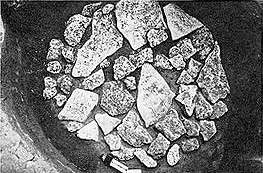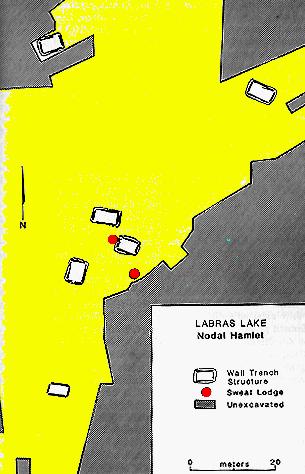
Limestone-lined pit from the Julian site.

A prestige item, the Ramey knife.

Labras Lake site, showing sweatlodges and
variation in structure sizes.
All of these characteristics may indicate more wealth, larger family size, or the use of the residence for non-household functions such as community meetings or ritual feasting. Some hamlets include obvious non-residential structures. Small circular structures with atypical hearths are believed to be sweatlogdges , probably indicative of ritual activity. Some non-residential structures contain an abundance of fine pottery (Ramey-Incised, red-slip jars, etc.) that appears to have been ritually broken. Other special purpose buildings are quite large, suggesting more civic functions. A large, open-sided structure with several benches and cooking hearths at one nodal site (Lohman Phase ML-I settlement at the Range site), for example, indicate a meeting place (Emerson 1997) for a clan (a group of people of common descent), moiety (one of two groups that a tribe is divided base on unilateral descent), or elders of a local lineage.
At a minimum these features indicate greater status and wealth of some rural locations. Whether or not they were the belongings of community headmen reporting to the chief at the village, town, or paramount center of Cahokia is unknown. We can, however, infer that certain community-wide religious and socio-political functions conferred the community identity. These nodal settlements apparently served many of the ceremonial and religious needs of the nearby farmstead commoners (Emerson & Milner 1981; Emerson 1992, 1995; Milner 1990, 1998). How nodal settlements may have been integrated with larger villages, mound towns, and the ceremonial center of Cahokia, and their level of independence from larger settlements are difficult to assess. Clues about how nodal settlements, villages, mound-towns and the mound center of Cahokia were integrated come from a variety of sources.